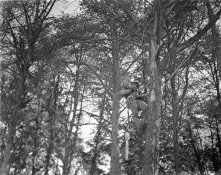ZorkiKat
Member
Four months ago, I brewed some of the paracetamol/acetaminophen "rodinal" recipe posted by Donald Qualls. It really works! A week or two after I used this developer, I posted my observations in other fora. The solution is now very dark- like strong coffee from Starbuck's- and has plenty of particulates floating around. These bits don't seem to matter- at dilutions of 1+50 or 1+100, very little actually goes in the working bath.
As Donald said, the dilutions and time/temperatures used with real Rodinal can be used. They can. The negatives developed in this paracetamol developer look every bit as the negatives I developed in Agfa Rodinal. Maybe there's some imperceptible differences, but in as far as the desireable Rodinal qualities like accutance and compensation go, they're there. The grain is sharp in a very Rodinal way.
I've also tried modifying Donald's recipe by substituting sodium metabisulfite for sodium sulphite and by adding a bit of potassium bromide. Again, these modifications did not seem to result in anything significant in as far as the developed negative is concerned.
This DIY developer formula is really useful for me. Real Agfa Rodinal has not been available here for the last 40 years (never was stocked in the local shops). Even the once common developers like D76, Microdol, and HC110 have also become scarce. Raw ingredients like metol are now almost impossible to find. But a developer which is made from common and readily-available (and unlikely to disappear) components is really heaven-sent. That is a very welcome alternative to having to import or buy through the internet developers or developer components. Though the more knowledgable may say that the paracetamol-derived Rodinal isn't the real thing, it's still better than having no developer at all.
The Rodinal I have came from Australia and Germany. I wish I knew about the paracetamol developer years ago when I always wanted to try Rodinal development and had many types of BW film to choose from.
Many thanks to Donald!
Jay
As Donald said, the dilutions and time/temperatures used with real Rodinal can be used. They can. The negatives developed in this paracetamol developer look every bit as the negatives I developed in Agfa Rodinal. Maybe there's some imperceptible differences, but in as far as the desireable Rodinal qualities like accutance and compensation go, they're there. The grain is sharp in a very Rodinal way.
I've also tried modifying Donald's recipe by substituting sodium metabisulfite for sodium sulphite and by adding a bit of potassium bromide. Again, these modifications did not seem to result in anything significant in as far as the developed negative is concerned.
This DIY developer formula is really useful for me. Real Agfa Rodinal has not been available here for the last 40 years (never was stocked in the local shops). Even the once common developers like D76, Microdol, and HC110 have also become scarce. Raw ingredients like metol are now almost impossible to find. But a developer which is made from common and readily-available (and unlikely to disappear) components is really heaven-sent. That is a very welcome alternative to having to import or buy through the internet developers or developer components. Though the more knowledgable may say that the paracetamol-derived Rodinal isn't the real thing, it's still better than having no developer at all.
The Rodinal I have came from Australia and Germany. I wish I knew about the paracetamol developer years ago when I always wanted to try Rodinal development and had many types of BW film to choose from.

Many thanks to Donald!
Jay

















